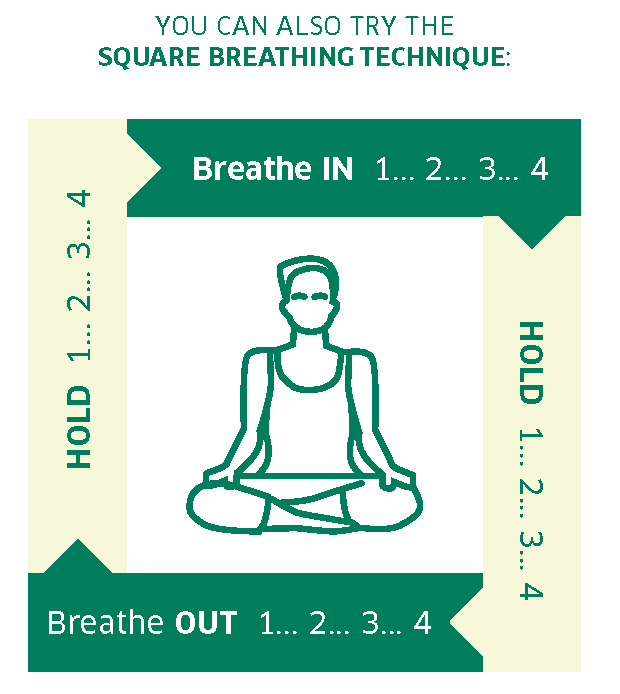If you are in distress, you can call or text 988 at any time. If it is an emergency, call 9-1-1 or go to your local emergency department.
- Public Resources, Reports
Quick Tips to Reduce Anxiety
1. Breathe 2. Ground yourself in the present 3. Remember that the feeling is temporary 4. Redirect your mind to a positive thought or activity 5. Move your body 1. Reframe your thoughts 2. Talk to someone Adults can text 988 (or 686868 for youth) at any time to speak to a trained volunteer. 3. Engage in leisure time and pleasurable activities 4. Practise relaxation methods If you turn to a relaxation or mediation app for guidance, try to be sure any claims they make are rooted in evidence. Read our tips on choosing mental health resources for further details. 5 Cultivate healthy habitsIn the moment…

If possible, move to quiet place. Some people find it helpful to close their eyes, if it’s safe to do so, to reduce stimulation. If not, try to find something to focus on. Take in a long, deep breath through your nose. Hold it for a few seconds, then slowly exhale through your mouth. Place a hand on your stomach to help you make sure you’re breathing deeply enough. You should be able to feel it inflate when inhaling and deflate when exhaling. Repeat as many times as you need to begin to feel calmer.
To place yourself in the present, turn your attention to what your senses are picking up. Try to identify at least one thing you can see, hear, feel, taste, and smell. If your mind wanders, that’s OK. Simply return to the present and continue.
While it may not feel like it in the moment, try to remind yourself (even speaking out loud if you’re comfortable doing so) that anxious feelings will pass. Anxiety comes in waves, and no matter how high, they will subside, and calmer waters will soon follow.
Try to identify a thought or action that you associate with calm. Maybe it’s taking a short break to make some tea or listening to music that’s more upbeat. When it’s not feasible to change activities, use mental imagery to travel somewhere that brings you comfort. Go to your happy place, so to speak.
Physical movement can reduce anxiety and help you stay in the present. If possible, try taking a walk outdoors when anxiety begins to climb. If you can’t do that, try stretching in your seat or moving around the room.When the moment passes, and in the longer term…
Try to identify what triggered the anxious thoughts and see if you can reframe the situation in a more realistic or positive light. Most anxious thoughts are future oriented and involve negative predictions. So try to distinguish what you know from what you are telling yourself (and may or may not come true). For example, you might have a triggering thought like this: “My task list is so long, I’ll never be able to get through it.” But if you stop and think it through, you may be able to reframe the situation in a more accurate and helpful way — something like, “I have lots to do, but I’ve managed heavy workloads before. I’ll tackle each task one by one and see how far I get in the time I have. That’s all I can ask of myself.”
Talking about stressors or worries with someone you trust can reduce anxiety and help you process your thoughts. Doing so can also be an important reminder that you aren’t as alone as you may feel. If anxious thought patterns become an ongoing concern, talk to your primary health-care provider or seek other professional mental health support. 
It’s important to put some time aside to do things for yourself. While it might be easier said than done, doing things you find enjoyable releases the feel-good chemicals in the brain that can help keep anxious feelings at bay. Try to jot down what you find most calming. That way, when you need to you can pull from your own tried-and-true options.
Relaxation techniques can be as simple as two minutes of deep breathing or as involved as a daily meditation practice. The most important thing is finding what works for you and to try to be as consistent as possible. Many people find engaging in mindfulness helpful for reducing anxiety, while others prefer gentle yoga or a walk around their local park.
Investing in your physical health will pay dividends for your mental well-being. Things like avoiding excess caffeine, getting adequate sleep, and exercising regularly can all help prevent and reduce anxiety. Proper nutrition and hydration are also important. Caring for your body will help give your mind the strength and energy it needs to overcome challenges, now and in the future.
- Public Resources, Reports
Quick Tips to Reduce Anxiety
Quick Tips to Reduce Anxiety
- COVID
1. Breathe 2. Ground yourself in the present 3. Remember that the feeling is temporary 4. Redirect your mind to a positive thought or activity 5. Move your body 1. Reframe your thoughts 2. Talk to someone Adults can text 988 (or 686868 for youth) at any time to speak to a trained volunteer. 3. Engage in leisure time and pleasurable activities 4. Practise relaxation methods If you turn to a relaxation or mediation app for guidance, try to be sure any claims they make are rooted in evidence. Read our tips on choosing mental health resources for further details. 5 Cultivate healthy habits
In the moment…

If possible, move to quiet place. Some people find it helpful to close their eyes, if it’s safe to do so, to reduce stimulation. If not, try to find something to focus on. Take in a long, deep breath through your nose. Hold it for a few seconds, then slowly exhale through your mouth. Place a hand on your stomach to help you make sure you’re breathing deeply enough. You should be able to feel it inflate when inhaling and deflate when exhaling. Repeat as many times as you need to begin to feel calmer.
To place yourself in the present, turn your attention to what your senses are picking up. Try to identify at least one thing you can see, hear, feel, taste, and smell. If your mind wanders, that’s OK. Simply return to the present and continue.
While it may not feel like it in the moment, try to remind yourself (even speaking out loud if you’re comfortable doing so) that anxious feelings will pass. Anxiety comes in waves, and no matter how high, they will subside, and calmer waters will soon follow.
Try to identify a thought or action that you associate with calm. Maybe it’s taking a short break to make some tea or listening to music that’s more upbeat. When it’s not feasible to change activities, use mental imagery to travel somewhere that brings you comfort. Go to your happy place, so to speak.
Physical movement can reduce anxiety and help you stay in the present. If possible, try taking a walk outdoors when anxiety begins to climb. If you can’t do that, try stretching in your seat or moving around the room.When the moment passes, and in the longer term…
Try to identify what triggered the anxious thoughts and see if you can reframe the situation in a more realistic or positive light. Most anxious thoughts are future oriented and involve negative predictions. So try to distinguish what you know from what you are telling yourself (and may or may not come true). For example, you might have a triggering thought like this: “My task list is so long, I’ll never be able to get through it.” But if you stop and think it through, you may be able to reframe the situation in a more accurate and helpful way — something like, “I have lots to do, but I’ve managed heavy workloads before. I’ll tackle each task one by one and see how far I get in the time I have. That’s all I can ask of myself.”
Talking about stressors or worries with someone you trust can reduce anxiety and help you process your thoughts. Doing so can also be an important reminder that you aren’t as alone as you may feel. If anxious thought patterns become an ongoing concern, talk to your primary health-care provider or seek other professional mental health support. 
It’s important to put some time aside to do things for yourself. While it might be easier said than done, doing things you find enjoyable releases the feel-good chemicals in the brain that can help keep anxious feelings at bay. Try to jot down what you find most calming. That way, when you need to you can pull from your own tried-and-true options.
Relaxation techniques can be as simple as two minutes of deep breathing or as involved as a daily meditation practice. The most important thing is finding what works for you and to try to be as consistent as possible. Many people find engaging in mindfulness helpful for reducing anxiety, while others prefer gentle yoga or a walk around their local park.
Investing in your physical health will pay dividends for your mental well-being. Things like avoiding excess caffeine, getting adequate sleep, and exercising regularly can all help prevent and reduce anxiety. Proper nutrition and hydration are also important. Caring for your body will help give your mind the strength and energy it needs to overcome challenges, now and in the future.
SHARE THIS PAGE
RELATED

Review our Assessment Framework for Mental Health Apps — a national framework containing key standards for safe, quality, and effective mental health apps in Canada.

To help expand the use of e-mental health services, we developed four online learning modules based on our Toolkit for E-Mental Health Implementation, in collaboration with the Centre for Addiction and Mental Health (CAMH).

Stepped Care 2.0© (SC2.0) is a transformative model for organizing and delivering evidence-informed mental health and substance use services.
